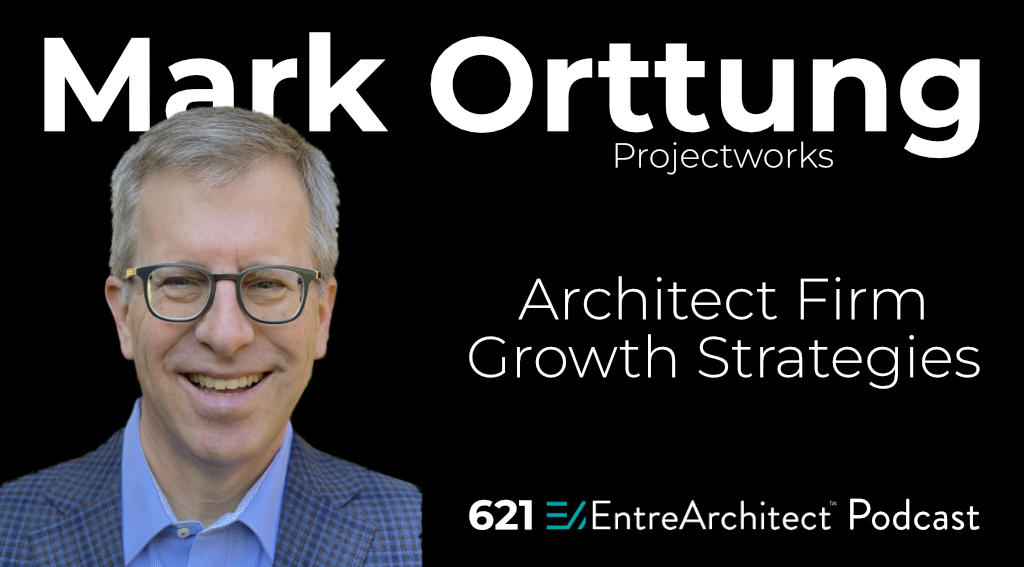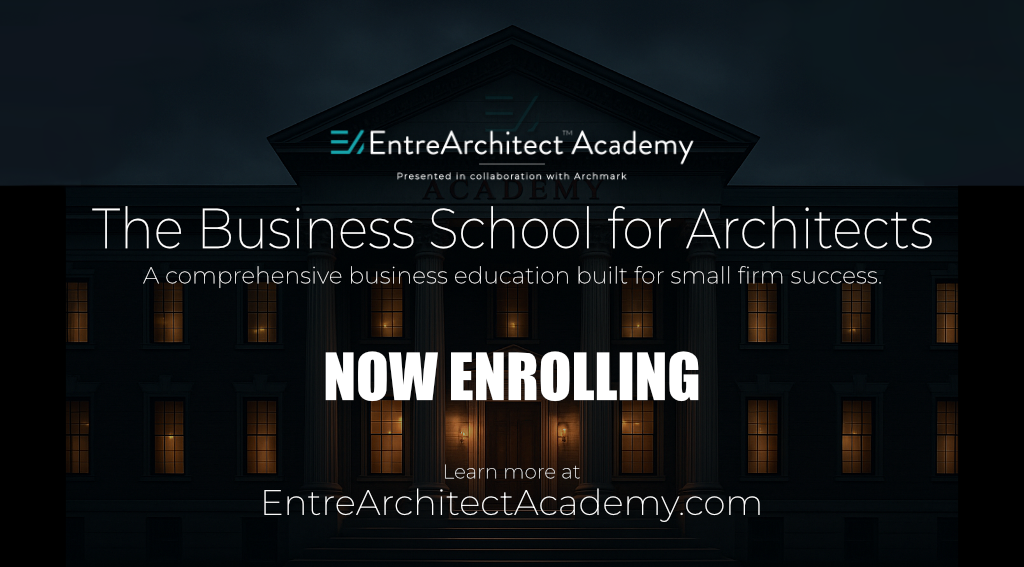
Starting With Clarity: Why Your Firm Exists
I love conversations that reveal a single idea you can take back to your firm and use immediately. My interview with Mark Orttung, CEO of Projectworks and chair of Provoke, delivered several. The biggest one is this: every strong firm begins with a crisp answer to why it exists and how it is different. At Nexient, the consultancy Mark led, that answer became a simple rallying cry: life’s too short for bad software. That focus gave the team permission to say no to average work and yes to the right work. It sharpened marketing, clarified hiring, and aligned delivery. For architects, the lesson is the same. When you define what makes your firm distinct, decisions get easier. You stop being all things to all people and start building authority with the right clients. This is not a feel-good exercise. It is an operating system for growth.
The Consulting Balance: Sell Then Hire
Mark framed the earliest stage of firm building as a constant balancing act between sold work and staff capacity. He calls it the consulting balance. There is a simple rule that protects cash and momentum in those fragile first months. “Sell then hire.” That does not mean you ignore recruiting until contracts are signed. It means you build a transparent bench while you sell, being honest with candidates about timing and fit. When the project closes, you are ready to make rapid, confident hires. Hire first, and you can bleed cash. Sell without a bench, and your client waits while you scramble. Sell then hire threads the needle.
The Founder’s Role in Early Growth
From two or three people up to twenty or so, the founder must do the heavy lifting on business development. Not because they love sales, but because early buyers want to talk with a practitioner who holds the vision. In our world, people buy from people they trust. Authentic conversations about real problems beat scripted pitches every time. Mark’s playbook is straightforward. Get visible. Show up where your clients are. Share stories about outcomes, not just process. Ask better questions than anyone else. And in those first meetings, flip the conversation to the client. Let them talk. Clarify the problem together. Capture their language. Follow up with a crisp summary that proves you heard them. That is how a practitioner sells.
Crossing the First Plateau: When the Founder Becomes the Bottleneck
There is a predictable wall around twenty to thirty people. The founder finally masters selling and delivery, then becomes the constraint. Mark’s solution is to pair roles. Keep a “door opener” who can qualify and frame opportunity, then bring in a practitioner early who can co-design the solution with the client. In many architecture firms, that practitioner is a project leader with the temperament to listen, diagram, and propose next steps in real time. This pairing scales what the founder was doing alone. It also builds a culture where selling is a learning exercise, not a performance. You listen to shape the problem. You sketch a path forward. You reduce risk by being useful before anyone signs a contract.
Design the Business to Spend More Time With Clients
Architects want to practice architecture. We want our time in studios, in meetings, on job sites, and in communities. The biggest drag on that work is manual administration. Mark’s stories from the field are familiar. Teams hand-entering time into a single spreadsheet on a single computer. Invoices assembled from memory at month-end. Resource decisions made by gut instead of data. The fix is not glamorous, but it is transformative. Move the business mechanics into systems that are easy to use, decentralized, and visible. Put time entry, expenses, resourcing, and invoicing in a shared tool so everyone can see the same truth in real time. Decisions get better when they are made by people close to the work, supported by current data. That is how you get more hours back on the client side of the ledger.
Share More Numbers Than You Think
Transparency fuels better decisions, but it does not need to be absolute to be effective. Mark’s approach balances clarity with privacy. Share rate and cost bands by role so project leaders understand margins and can staff intelligently. Reserve individual compensation for those who need to know. Then bring more people into your monthly business review. When teams see pipeline, utilization, cash timing, and project margin, they start solving problems before they become emergencies. That cultural shift alone is worth the effort. It turns the firm into a team of stewards rather than a handful of firefighters.
The Growth Mindset as Daily Practice
Setbacks are guaranteed. Mark tells the story of shrinking Nexient’s revenue for six straight quarters while he was learning how to be a CEO. He walked into a board meeting, named the elephant in the room, made the best case he could, and earned one more quarter. That was the quarter the numbers turned up. The lesson is not about luck. It is about posture. Read Carol Dweck’s Mindset and make it part of your firm’s language. When something does not work, treat it as information. Close the loop. Try the next iteration. The teams that win run the most intelligent experiments in the least amount of time, with the least amount of drama.
Recognize the Pattern of Adoption
Mark referenced Geoffrey Moore’s technology adoption lifecycle as a lens for every new idea. Early on you need visionary clients who will try something new with you. Then you cross into the early majority as your proof builds. This matters for architects because many of us are introducing new methods, materials, and delivery models to conservative markets. If you recognize where your idea sits on that curve, you can tailor both expectations and messaging. With early adopters, you sell possibilities. With the majority, you sell proof. Name the stage and you will choose wiser partners, set better scopes, and forecast revenue with fewer surprises.
Build for AI Now, Not Later
Two things are true at once. Your firm needs a clean, trusted system of record. Your firm also needs richer knowledge than any timecard or invoice can carry. AI allows both. Mark described near-term capabilities where your platform ingests proposals, contracts, models, and work logs to draft the project narratives nobody has time to write. It will assemble a credible first pass at a team member’s CV, outline project challenges and solutions, and then ask for quick confirmation. The human still approves. The machine reduces the blank page and captures the learning. Imagine staffing decisions, proposals, and marketing assets built from living data, not Monday morning memory. If you start collecting and structuring that information now, you will be ready to ride the wave rather than chase it.
Say No So You Can Grow
The scariest and most liberating shift Mark described was ruthless focus. When Nexient committed to being excellent at one thing, they had to say no to good but off-strategy work. That commitment took them from thirty-five million to one hundred thirty million. For architecture firms, the courage to specialize often shows up as better clients, clearer scopes, more repeatable delivery, and higher margins. It also shows up as fewer late nights doing work you do not want to be known for. Specialization is not a prison. It is a promise to the market and your team about where you will invest your craft.
Practical Moves You Can Make This Week
These ideas from Mark Orttung are practical enough to implement this week and powerful enough to change the way your firm operates. Each one creates clarity, builds momentum, and frees up more time to spend with clients.
- Draft a two-person selling model. Identify your best door opener and your most trusted practitioner. Put them in early client conversations together so they learn from each other and close better work, faster.
- Write your differentiation in one sentence and share it with your team. If it takes a paragraph, keep refining it until you can say it in a breath.
- Map your near-term pipeline and your current capacity on a single view.
- Decide which roles to begin recruiting for now, and which offers you will make only after the next contract closes.
- Schedule a monthly financial review open to more than just the partners. Bring project leaders into the room and show revenue, margin by project, utilization, and cash timing.
- Pick one administrative task your team hates. Automate it or move it into a system everyone can access from anywhere.
- Set a firm-wide experiment cadence: one process improvement, one marketing test, and one fee strategy. Measure outcomes and share what you learn.
One Small Action for a Better Firm Tomorrow
If you do nothing else after reading this, get painfully clear on your firm’s why and what makes you different. It will influence the clients you attract, the fees you command, the people you hire, and the systems you install. It will give you the confidence to sell then hire, the courage to share more numbers, and the discipline to say no. The firms that thrive in the next few years will not be the ones with the longest service lists. They will be the ones with the clearest promises, the cleanest data, and the strongest habits. That is well within your reach.
If this conversation resonated, you will enjoy the full episode with Mark Orttung. We dug deeper into the early days at Bill.com, how to face hard quarters with calm, and what AI will actually do for small firms.
Listen here: https://entrearchitect.com/621.

Leave a Reply